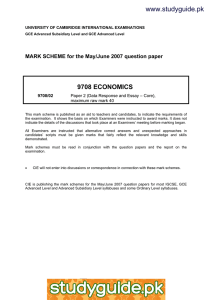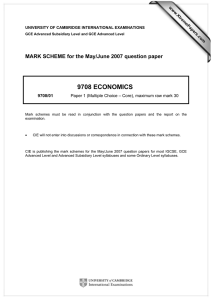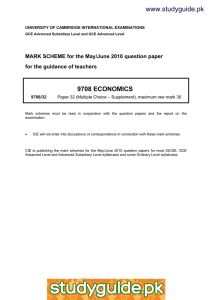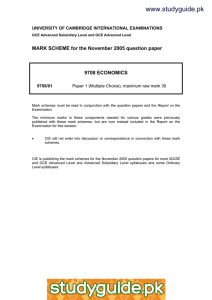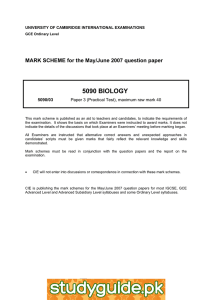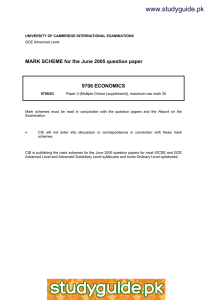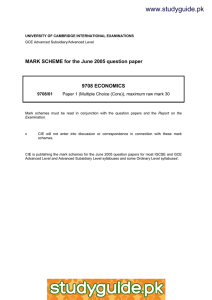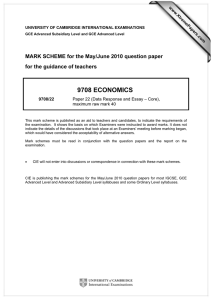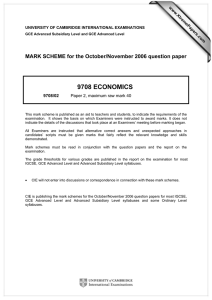9708 ECONOMICS MARK SCHEME for the May/June 2007 question paper
advertisement
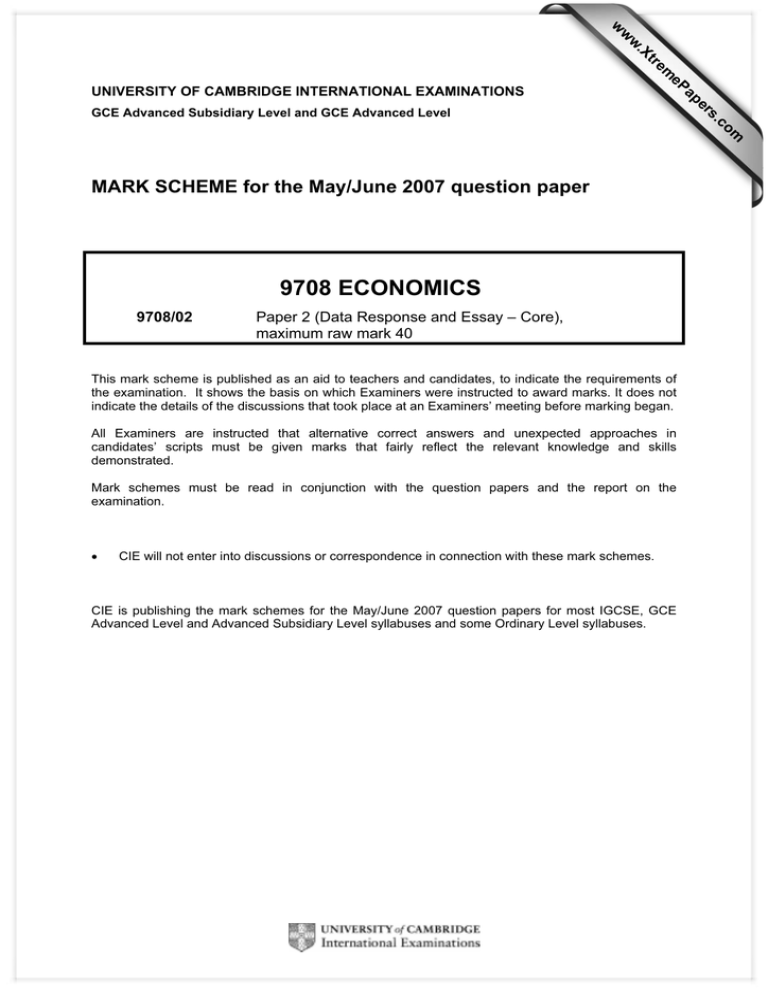
w w ap eP m e tr .X w UNIVERSITY OF CAMBRIDGE INTERNATIONAL EXAMINATIONS 9708 ECONOMICS 9708/02 Paper 2 (Data Response and Essay – Core), maximum raw mark 40 This mark scheme is published as an aid to teachers and candidates, to indicate the requirements of the examination. It shows the basis on which Examiners were instructed to award marks. It does not indicate the details of the discussions that took place at an Examiners’ meeting before marking began. All Examiners are instructed that alternative correct answers and unexpected approaches in candidates’ scripts must be given marks that fairly reflect the relevant knowledge and skills demonstrated. Mark schemes must be read in conjunction with the question papers and the report on the examination. • CIE will not enter into discussions or correspondence in connection with these mark schemes. CIE is publishing the mark schemes for the May/June 2007 question papers for most IGCSE, GCE Advanced Level and Advanced Subsidiary Level syllabuses and some Ordinary Level syllabuses. om .c MARK SCHEME for the May/June 2007 question paper s er GCE Advanced Subsidiary Level and GCE Advanced Level Page 2 1 Mark Scheme GCE A/AS LEVEL – May/June 2007 Syllabus 9708 Paper 02 (a) (i) Draw a production possibility curve to show the trade-off between the provision of educational and popular television programmes. Explain the possible effects if more money is available to the programme makers from increased licence fees. Diagram of ppc with labels (1), identification of output change in diagram or words (1), explanation of effect (1). [3] (ii) Explain how an increase in the licence fee to receive television programmes may affect the market for TV sets. Licence is a complement or in joint demand or has negative XED (1), higher licence cost reduces demand for TVs (1), + 2 from: lowers TV price (1), lowers quantity traded (1), lowers revenue/profit (1), Credit diagram if changes shown. [4] (b) How does Fig. 1 support the view that the BBC creates more value than viewers pay for? Understanding of consumer surplus (2), identification of expenditure and consumer surplus areas in words or diagram (2). Credit net benefit approach. [4] (c) (i) Comment on the relative positions in Fig. 2 of national defence and police services. Defence has greater non-rivalry and non-excludability (1), Defence is a better example of a public good (1), reasons for differences (2), to 3 marks max. [3] (ii) Discuss whether it is correct to include education and health as public goods in Fig. 2. Not usually considered a public good (1), explanation of not being a public good (3), rather a private good or merit good (1), explanation of being a private or merit good (3), to a max of 6 marks. © UCLES 2007 [6] Page 3 2 Mark Scheme GCE A/AS LEVEL – May/June 2007 Syllabus 9708 Paper 02 (a) Explain the contributions of enterprise and division of labour to an economy. Enterprise is the risk-taking, organising factor of production; D of L is the specialisation of economic activity by product or process. Enterprise organises the other factors to promote output, efficiency and change while D of L reduces cost, raises productivity and living standards. Meaning and nature of enterprise and D of L (4) Explanation of contribution to economy (4) [8] (b) Discuss the desirability of the worldwide movement towards the market economy and away from the planned economy. The market economy has limited government intervention and relies on the profit motive and consumer sovereignty. It has proved more successful in raising living standards, economic growth and economic efficiency. Consumers benefit from more choice and lower prices. Planned economies were state-run with economic plans and large scale government intervention. The result was low living standards although employment was usually available and a basic quality of life resulted. The move to market economies brought beneficiaries and casualties. Russia illustrates the increase in millionaires while unemployment and poverty grew. Some East European economies are making fast progress while some former USSR republics are struggling. Candidates may consider the case of China. Understanding of the features of economic systems (4) Discussion of the benefits of the transition (4) Discussion of the harm of the transition (4) 3 [12] (a) Explain how the rate of inflation is measured. Inflation is a sustained rise in the general price level, measured by a price index. Its main features are a basket of goods, a base year, weighting and data collection. Data is calculated at different times to show changes in the index and rate of inflation. Understanding of inflation (2) Explanation of the construction of a price index (6) [8] (b) Discuss how a rapid rate of inflation might affect different groups within an economy. Rapid inflation will harm all groups through reducing real values, creating uncertainty, instability and harming the efficient operation of the market system. The level of inflation will influence the severity of any effects. Those who benefit include the government, borrowers, importers and some producers. Those who suffer include fixed income earners, lenders, exporters and some producers. Understanding of general effects and importance of relative rate of inflation (4) Discussion of those who benefit (4) Discussion of those who suffer (4) © UCLES 2007 [12] Page 4 4 Mark Scheme GCE A/AS LEVEL – May/June 2007 Syllabus 9708 Paper 02 (a) Explain the difference between expenditure-switching and expendituredampening policies as a means of correcting a balance of payments disequilibrium. Disequilibrium involves persistent deficit or surplus problems, which are not sustainable. Switching intends to move domestic and foreign expenditure more towards domestic production. It includes tariffs, quotas and subsidies and should mean more exports and fewer imports. Dampening involves reducing the level of total spending so reducing imports and forcing domestic producers to export. Deflationary fiscal and monetary policy would be used. Understanding of the terms (4) Details of the two types of policy (4) [8] (b) Outline the current account position of your country or another economy you have studied. Discuss its ability to improve its performance on the current account. The position on trade in goods and services, income and transfers needs to be identified in terms of surplus or deficit. Policies to improve competitiveness through price and quality, to introduce new exports and reduce imports, to gain access to new markets, to influence income and transfer flows need to be specified. The ability to implement these policies successfully depends upon the background conditions, the effectiveness of the policies, costs, expertise, influence and external obstacles. Cases may vary markedly between countries. Analysis of current account position (4) Consideration of policies for improvement (4) Discussion of ability to effect an improvement (4) © UCLES 2007 [12]
